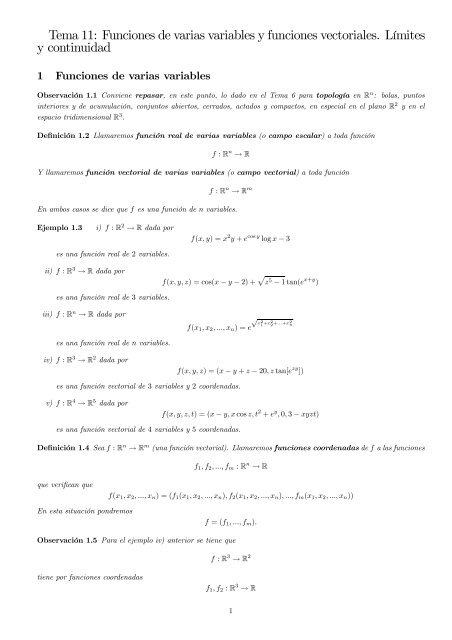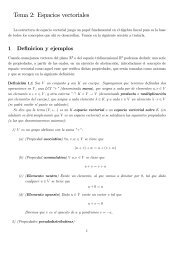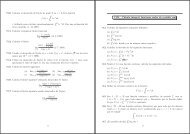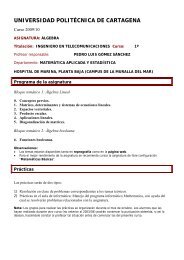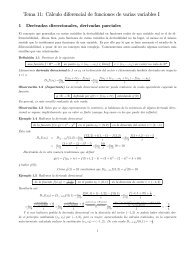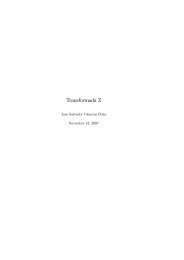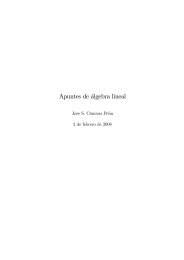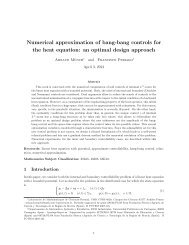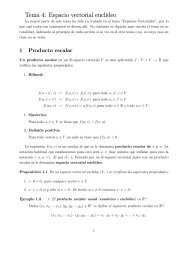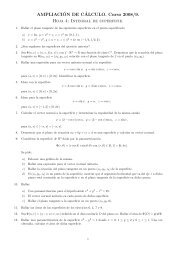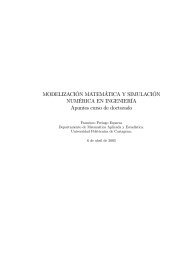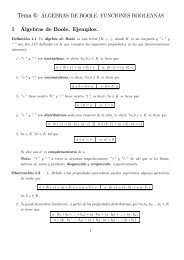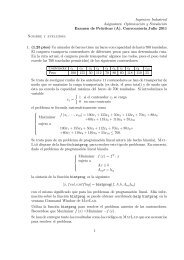Tema 11: Funciones de varias variables y funciones vectoriales ...
Tema 11: Funciones de varias variables y funciones vectoriales ...
Tema 11: Funciones de varias variables y funciones vectoriales ...
Create successful ePaper yourself
Turn your PDF publications into a flip-book with our unique Google optimized e-Paper software.
<strong>Tema</strong> <strong>11</strong>: <strong>Funciones</strong> <strong>de</strong> <strong>varias</strong> <strong>variables</strong> y <strong>funciones</strong> <strong>vectoriales</strong>. Límites<br />
y continuidad<br />
1 <strong>Funciones</strong> <strong>de</strong> <strong>varias</strong> <strong>variables</strong><br />
Observación 1.1 Conviene repasar, enestepunto,lodadoenel<strong>Tema</strong>6paratopología en R n : bolas, puntos<br />
interiores y <strong>de</strong> acumulación, conjuntos abiertos, cerrados, actados y compactos, en especial en el plano R 2 yenel<br />
espacio tridimensional R 3 .<br />
Definición 1.2 Llamaremos función real <strong>de</strong> <strong>varias</strong> <strong>variables</strong> (o campo escalar) a toda función<br />
f : R n → R<br />
Yllamaremosfunción vectorial <strong>de</strong> <strong>varias</strong> <strong>variables</strong> (o campo vectorial) a toda función<br />
f : R n → R m<br />
En ambos casos se dice que f es una función <strong>de</strong> n <strong>variables</strong>.<br />
Ejemplo 1.3<br />
i) f : R 2 → R dada por<br />
f(x, y) =x 2 y + e cos y log x − 3<br />
es una función real <strong>de</strong> 2 <strong>variables</strong>.<br />
ii) f : R 3 → R dada por<br />
f(x, y, z) =cos(x − y − 2) + p z 5 − 1tan(e x+y )<br />
es una función real <strong>de</strong> 3 <strong>variables</strong>.<br />
iii) f : R n → R dada por<br />
√<br />
x<br />
f(x 1 ,x 2 , ..., x n )=e<br />
2 1 +x2 2 +...+x2 n<br />
es una función real <strong>de</strong> n <strong>variables</strong>.<br />
iv) f : R 3 → R 2 dada por<br />
f(x, y, z) =(x − y + z − 20,ztan[e zy ])<br />
es una función vectorial <strong>de</strong> 3 <strong>variables</strong> y 2 coor<strong>de</strong>nadas.<br />
v) f : R 4 → R 5 dada por<br />
f(x, y, z, t) =(x − y, x cos z,t 2 + e y , 0, 3 − xyzt)<br />
es una función vectorial <strong>de</strong> 4 <strong>variables</strong> y 5 coor<strong>de</strong>nadas.<br />
Definición 1.4 Sea f : R n → R m (una función vectorial). Llamaremos <strong>funciones</strong> coor<strong>de</strong>nadas <strong>de</strong> f a las <strong>funciones</strong><br />
f 1 ,f 2 , ..., f m : R n → R<br />
que verifican que<br />
f(x 1 ,x 2 , ..., x n )=(f 1 (x 1 ,x 2 , ..., x n ),f 2 (x 1 ,x 2 ,...,x n ), ..., f m (x 1 ,x 2 , ..., x n ))<br />
En esta situación pondremos<br />
f =(f 1 ,...,f m ).<br />
Observación 1.5 Para el ejemplo iv) anterior se tiene que<br />
f : R 3 → R 2<br />
tiene por <strong>funciones</strong> coor<strong>de</strong>nadas<br />
f 1 ,f 2 : R 3 → R<br />
1
dadas por<br />
f 1 (x, y, z) = x − y + z − 20<br />
f 2 (x, y, z) = z tan[e xy ]<br />
Para el ejemplo v) anterior se tiene que<br />
f : R 4 → R 5<br />
tiene por <strong>funciones</strong> coor<strong>de</strong>nadas<br />
f 1 ,f 2 ,f 3 ,f 4 ,f 5 : R 4 → R<br />
dadas por<br />
f 1 (x, y, z, t) =x − y f 2 (x, y, z, t) =x cos z f 3 (x, y, z, t) =t 2 + e y f 4 (x, y, z, t) =0 f 5 (x, y, z, t) =3− xyzt<br />
Igual que en el caso <strong>de</strong> <strong>funciones</strong> reales <strong>de</strong> una variable real (f : R → R) se entien<strong>de</strong> por dominio <strong>de</strong> una función<br />
<strong>de</strong> <strong>varias</strong> <strong>variables</strong> al conjunto <strong>de</strong> puntos <strong>de</strong> R n en el cual tienen sentido todas las expresiones que <strong>de</strong>finen a la función.<br />
Si f =(f 1 ,f 2 , ..., f m ) es una función vectorial se tiene a<strong>de</strong>más que<br />
Domf = Domf 1 ∩ ... ∩ Domf m .<br />
De todos modos, al igual que ocurría con <strong>funciones</strong> reales <strong>de</strong> variable real, el dominio pue<strong>de</strong> estar restringido sin<br />
necesidad <strong>de</strong> ser el dominio máximo posible.<br />
Observación 1.6 En el ejemplo i) anterior el dominio está formado por todos los puntos (x, y) que cumplen que<br />
x>0.<br />
En el ejemplo ii) el dominio está formado por todos los puntos (x, y, z) <strong>de</strong> R 3 que verifican z 5 −1 ≥ 0 y cos(e x+y ) 6=<br />
0, simultáneamente.<br />
En el ejemplo iii) el dominio es todo R n , así como en el ejemplo v).<br />
Finalmente en el ejemplo iv) el dominio está formado por todos los puntos (x, y, z) <strong>de</strong> R 3 que verifican cos(e zy ) 6= 0.<br />
El dominio <strong>de</strong> la función<br />
1<br />
f(x, y) =cos(<br />
x 2 + y 2 )<br />
es todo R 2 salvo el punto (0, 0) (observar que es el único punto que hace nula la suma <strong>de</strong> cuadrados x 2 + y 2 .<br />
Para la función<br />
g(x, y) = x2 + y 2<br />
xy<br />
el dominio es<br />
Domg = {(x, y) ∈ R 2 tales que xy 6= 0},<br />
en <strong>de</strong>finitiva todo R 2 salvo los ejes coor<strong>de</strong>nados x =0e y =0.<br />
Y el dominio <strong>de</strong> la función h(x, y) =( x2<br />
y , log(x − y), √ x 2 − 1) es<br />
Domh = {(x, y) ∈ R n : y 6= 0,x− y>0,x 2 − 1 ≥ 0}.<br />
La gráfica <strong>de</strong> una función f : R n → R m es el siguiente conjunto <strong>de</strong> puntos <strong>de</strong> R n+m<br />
Casos don<strong>de</strong> pue<strong>de</strong> visualizarse la gráfica:<br />
{(x 1 ,x 2 , ..., x n ,f(x 1 ,x 2 , ..., x n )) ∈ R n+m :(x 1 ,x 2 , ..., x n ) ∈ Domf}.<br />
• Una función real <strong>de</strong> variable real f : R → R. En este caso la gráfica es una curva en R 2 , que está formada por<br />
todos los puntos <strong>de</strong> la forma (x, f(x)), don<strong>de</strong> x recorre el dominio <strong>de</strong> f. Ésta es la situación que hemos analizado<br />
en el <strong>Tema</strong> 6 <strong>de</strong> la asignatura.<br />
• Una función real <strong>de</strong> dos <strong>variables</strong> f : R 2 → R. Enestecasolagráfica es una superficie, queestáformada<br />
por todos los puntos <strong>de</strong> la forma (x, y, f(x, y)), don<strong>de</strong> (x, y) recorre el dominio <strong>de</strong> f. Éstaserálasituaciónque<br />
analizaremos en el presente tema y en los restantes.<br />
2
• Una función vectorial <strong>de</strong> una variable f : R → R n , cuando n =2, 3. Enestecasotenemosloquese<strong>de</strong>nomina<br />
una curva parametrizada en R 2 ó R 3 . Ésta es una situación especial que se visualiza <strong>de</strong> otro modo que no vamos<br />
a tratar con <strong>de</strong>talle aquí.<br />
A continuación vemos algunas superficies:<br />
Esfera x 2 + y 2 + z 2 =1 Cilindro x 2 + y 2 =1 Cono z 2 = x 2 + y 2<br />
Parabolio<strong>de</strong> z = x 2 + y 2 Silla <strong>de</strong> montar z = x 2 − y 2 Toro z 2 =1− ( p x 2 + y 2 − 2) 2<br />
La figura ocho Una espiral La hélice circular<br />
Debidoalacomplejida<strong>de</strong>xistenteengeneralalahora <strong>de</strong> abordar el problema <strong>de</strong> la representación gráfica <strong>de</strong> una<br />
superficie z = f(x, y). se hace necesario otro recurso que facilite en buena medida esta labor. Así po<strong>de</strong>mos utilizar<br />
las curvas <strong>de</strong> nivel, que son las proyecciones sobre el plano OXY <strong>de</strong> los puntos <strong>de</strong> la superficie que están a cierta<br />
3
altura constante (para cada altura k al hacer la proyección sobre el plano OXY <strong>de</strong> la superficie obtenemos la curva<br />
<strong>de</strong> nivel {(x, y) :f(x, y) =k). Algunas pinceladas sobre esto comentaremos en el apéndice.<br />
2 Límite <strong>de</strong> <strong>funciones</strong> <strong>de</strong> <strong>varias</strong> <strong>variables</strong><br />
La i<strong>de</strong>a intuitiva <strong>de</strong> límite es similar a la <strong>de</strong>l caso <strong>de</strong> <strong>funciones</strong> reales <strong>de</strong> una variable real, con las generalizaciones<br />
correspondientes.<br />
Consi<strong>de</strong>remos una función real <strong>de</strong> <strong>varias</strong> <strong>variables</strong><br />
f : Ω ⊆ R n → R<br />
y x 0 =(a 1 ,a 2 , ..., a n ) un punto <strong>de</strong> acumulación <strong>de</strong> Ω (recor<strong>de</strong>mosqueestosedacuandotodabolacentradaenx 0<br />
contiene infinitos puntos <strong>de</strong> Ω; en a<strong>de</strong>lante cuando estudiemos el límite en un punto siempre supondremos que estamos<br />
con un punto <strong>de</strong> acumulación).<br />
Diremos que L ∈ R es el límite <strong>de</strong> f cuando<br />
x =(x 1 ,x 2 , ..., x n ) tien<strong>de</strong> hacia x 0 através<strong>de</strong>Ω (también se dice que es el límite restringido a Ω) cuando<br />
se cumple que<br />
para todo ε > 0 existe un ∂ > 0 tal que si x ∈ B(x 0 , δ),x∈ Ω, x 6= x 0 , entonces |f(x) − L| < ε. Esto lo <strong>de</strong>notaremos<br />
<strong>de</strong> alguna <strong>de</strong> las siguientes maneras<br />
lim<br />
f(x 1,x 2 , ..., x n )=L lim f(x) =L lim<br />
(x 1,x 2,...,x n)→(a 1,a 2,...,a n),x∈Ω x→x 0 ,x∈Ω<br />
x → x 0<br />
x ∈ Ω<br />
f(x) =L<br />
Observación 2.1 Rigurosamente hablando es preciso, como se indica anteriormente, para siquiera plantear la existencia<br />
<strong>de</strong>l límite <strong>de</strong> una función f en un punto x 0 através<strong>de</strong>unconjuntoΩ, quedichopuntosea<strong>de</strong>acumulación<strong>de</strong>l<br />
conjunto. En lo sucesivo, aunque no hagamos mención <strong>de</strong> tal <strong>de</strong>talle, cada vez que se plantee un límite, supondremos<br />
que ocurrirá así, es <strong>de</strong>cir, el punto será <strong>de</strong> acumulación <strong>de</strong>l conjunto, aunque no hagamos mención expresa <strong>de</strong> ello.<br />
Es conveniente especificar claramente el conjunto Ω enelquesetomanlospuntosatravés<strong>de</strong>loscualespreten<strong>de</strong>mos<br />
aproximarnos hacia x 0 , pues la cosa pue<strong>de</strong> variar si lo cambiamos. El caso más habitual es que pretendamos<br />
aproximarnos al punto x 0 a través <strong>de</strong>l conjunto más amplio posible, el dominio <strong>de</strong> la función, para el que pondremos<br />
lim f(x) =L y al que nos referiremos simplemente diciendo que L es el límite <strong>de</strong> f cuando x tien<strong>de</strong> hacia x 0 (como<br />
x→x 0<br />
√ √<br />
ocurría con lim x =0ó lim log x = −∞, que po<strong>de</strong>mos poner, respectivamente, lim<br />
x→0 + x→0 +<br />
x =0ó lim log x = −∞,<br />
x→0<br />
x→0<br />
dando por hecho que el límite sólo pue<strong>de</strong> hacerse por la <strong>de</strong>recha, es <strong>de</strong>cir, a través <strong>de</strong>l conjunto {x : x>0}).<br />
En lo sucesivo, las propieda<strong>de</strong>s que enunciemos acerca <strong>de</strong>l límite a través <strong>de</strong>l dominio podrán ser generalizadas<br />
para límites a través <strong>de</strong> algún conjunto Ω.<br />
De modo similar se <strong>de</strong>fine el límite <strong>de</strong> una función vectorial <strong>de</strong> <strong>varias</strong> <strong>variables</strong><br />
sólo que L no es un número real sino un vector<br />
f : R n → R m<br />
L =(L 1 , ..., L m ) ∈ R m<br />
y entonces lo que <strong>de</strong>be ser inferior que ε es la distancia entre f(x) y L (esto último pue<strong>de</strong> escribirse <strong>de</strong> modo equivalente<br />
diciendo que f(x) ∈ B(L, ε)).<br />
En principio la i<strong>de</strong>a inicial que tenemos <strong>de</strong> límite consiste, como ocurría para las <strong>funciones</strong> reales <strong>de</strong> una variable,<br />
es sustituir en el punto:<br />
x<br />
Ejemplo 2.2 1. lim<br />
2 +y 2 −2<br />
(x,y)→(0,1)<br />
1+x cos y = −1<br />
1 = −1<br />
2. lim<br />
(x,y)→(−2,π) [sin y − 3cos(yx)]2 =[sinπ − 3cos(−2π)] 2 =[0− 3] 2 =9<br />
3. lim<br />
(x,y,z)→(1,−1,0) x2 y 3 (z +2)− 4=1 2 (−1) 3 · 2 − 4=−2 − 4=−6<br />
4
4. lim<br />
(x,y)→(3,0) ( x e y , y−1<br />
3x , 5) = ( 3 1 , −1<br />
9 , 5) = (3, − 1 9 , 5)<br />
Veamos cómo pue<strong>de</strong> cambiar la cosa si nos acercamos a través <strong>de</strong> diversos conjuntos:<br />
Ejemplo 2.3 Dada la función<br />
f(x, y) = 9x2 − y 2<br />
x 2 + y 2<br />
<strong>de</strong>finida para todo punto excepto para el origen (0, 0), vamos a <strong>de</strong>terminar el valor <strong>de</strong>l límite <strong>de</strong> la función cuando nos<br />
acercamos al origen, a través <strong>de</strong> los siguientes conjuntos:<br />
1. La recta y = x,<br />
2. La recta y =3x,<br />
3. La parábola x = y 2 ,<br />
9x 2 − y 2<br />
lim<br />
(x,y)→(0,0),y=x x 2 + y 2 =lim 9x 2 − x 2<br />
x→0 x 2 + x 2 = lim 8x 2<br />
x→0 2x 2 =4<br />
9x 2 − y 2<br />
lim<br />
(x,y)→(0,0),y=3x x 2 + y 2 =lim 9x 2 − 9x 2<br />
x→0 x 2 +9x 2 = lim 0<br />
x→0 10x 2 = lim 0=0<br />
x→0<br />
9x 2 − y 2<br />
lim<br />
(x,y)→(0,0),x=y 2 x 2 + y 2 =lim 9y 4 − y 2<br />
y→0 y 4 + y 2 =lim 9y 2 − 1<br />
y→0 y 2 +1 = −1<br />
También es posible que los límites <strong>de</strong> <strong>funciones</strong> <strong>de</strong> <strong>varias</strong> <strong>variables</strong> sean infinitos, generalizando la <strong>de</strong>finición dada<br />
para <strong>funciones</strong> reales <strong>de</strong> una variable. Por ejemplo una función f : R n → R posee límite +∞ cuando x tien<strong>de</strong> a x 0 si<br />
para todo M existe un δ > 0 <strong>de</strong> modo que si x ∈ B(x 0 , δ), x 6= x 0 , entonces f(x) >M(se pue<strong>de</strong> exten<strong>de</strong>r<br />
la situación al caso en que el límite valga −∞ ó ∞). Para una función vectorial f : R n → R m pondremos que<br />
lim f(x) =∞ cuando para todo M>0 existe un δ > 0 <strong>de</strong> modo que si x ∈ B(x 0 , δ) x 6= x 0 ,entonceselmódulo<strong>de</strong>l<br />
x→x 0<br />
vector f(x) es mayor que M (así que la imagen <strong>de</strong> la función se sale <strong>de</strong> toda bola finita que escojamos).<br />
Ejemplo 2.4<br />
x+1<br />
lim<br />
(x,y)→(0,0)<br />
y<br />
= 1 0 = ∞ lim 1+x<br />
(x,y)→(2,0)<br />
(x−2) 2 +y<br />
= 3 2 0<br />
=+∞ lim (2y, 3<br />
(x,y)→(1,−3)<br />
x−1 )=∞<br />
2.1 Operaciones con límites<br />
Para <strong>de</strong>terminar la existencia <strong>de</strong>l límite <strong>de</strong> una función vectorial basta estudiar el límite <strong>de</strong> sus <strong>funciones</strong> coor<strong>de</strong>nadas.<br />
De este modo nos centraremos en estudiar límites <strong>de</strong> <strong>funciones</strong> reales. Esto se <strong>de</strong>be al siguiente resultado:<br />
Propiedad: Sea<br />
f =(f 1 ,f 2 , ..., f m ):R n → R m<br />
y x 0 ∈ R n . Se tiene que existe lim f(x) yvaleL =(L 1 ,L 2 , ..., L m ) si y sólo si existen los límites <strong>de</strong> las <strong>funciones</strong><br />
x→x 0<br />
coor<strong>de</strong>nadas<br />
lim f 1 (x), lim f 2 (x)..., lim f m (x)<br />
x→x 0 x→x 0 x→x 0<br />
yvalenL 1 ,..., L m , respectivamente. En conclusión<br />
µ<br />
<br />
lim<br />
x→x 0<br />
f(x) = lim<br />
x→x 0<br />
(f 1 (x),f 2 (x), ..., f m (x)) =<br />
Ejemplo 2.5 Para f : R 3 → R 2 dada por<br />
f(x, y, z) =(x − y + z − 20,ztan[ π 4 ezy ])<br />
lim f 1 (x), lim f 2 (x), ..., lim f m (x)<br />
x→x 0 x→x 0 x→x 0<br />
se tiene que<br />
lim<br />
(x,y,z)→(1,0,−1)<br />
f(x, y, z) = lim (x − y + z − 20,ztan[π (x,y,z)→(1,0,−1) 4 ezy ]) =<br />
= ( lim<br />
(x,y,z)→(1,0,−1)<br />
[x − y + z − 20], lim z tan[π (x,y,z)→(1,0,−1) 4 ezy ]) =<br />
= (−20, − tan π 4 )=(−20, −1) 5
Y al igual que ocurría para el caso <strong>de</strong> <strong>funciones</strong> reales <strong>de</strong> una variable real se tratan las operaciones usuales<br />
para las <strong>funciones</strong> <strong>de</strong> <strong>varias</strong> <strong>variables</strong>, siempre que tengan sentido. Así:<br />
Propiedad: Sean f : R n → R m y g : R n → R m <strong>funciones</strong> para las que existe el límite y es finito cuando la variable<br />
tien<strong>de</strong> a un punto x 0 yseanα y β números reales. Entonces<br />
lim [f(x) ± g(x)] = lim f(x)± lim g(x)<br />
x→x 0 x→x 0 x→x 0<br />
lim [αf(x)] = α<br />
x→x 0<br />
A<strong>de</strong>más en el caso en que m =1(es <strong>de</strong>cir, cuando las <strong>funciones</strong> no son <strong>vectoriales</strong> sino reales) se tiene:<br />
Sean f,g : R n → R <strong>funciones</strong> para las que existe el límite y es finito cuando la variable tien<strong>de</strong> a un punto x 0 .<br />
Entonces<br />
lim f(x)<br />
f(x)<br />
lim [f(x) · g(x)] = lim f(x)· lim g(x) lim<br />
x→x 0 x→x 0 x→x 0 x→x 0 g(x) = x→x 0<br />
lim g(x)<br />
x→x 0<br />
(esto último tiene sentido si lim g(x) 6= 0).<br />
x→x 0<br />
A<strong>de</strong>más, estos resultados también son válidos para algunas situaciones <strong>de</strong> las distintas <strong>de</strong> las anteriores, como<br />
algunas en las que interviene algún infinito (<strong>de</strong> modo análogo a como ocurría para <strong>funciones</strong> <strong>de</strong> una variable: ver la<br />
Sección ”Operaciones Simbólicas” <strong>de</strong>l <strong>Tema</strong> 6):<br />
Ejemplo 2.6<br />
lim e −y<br />
x 2 = e −∞ =0<br />
(x,y)→(0,1)<br />
Nosplanteamosahoralarelación existente entre los límites a través <strong>de</strong> diferentes conjuntos. Setieneque:<br />
Propiedad: Dada f : Ω ⊆ R n → R m y un punto x 0 , si lim f(x) existe y vale L entonces para todo<br />
x→x 0 ,x∈Ω<br />
subconjunto Ω 0 ⊆ Ω se tiene que lim f(x) existe y vale L.<br />
x→x 0 ,x∈Ω0 En el caso particular <strong>de</strong> que pretendamos realizar el límite (a través <strong>de</strong>l dominio) obtenemos que si existe lim f(x)<br />
x→x 0<br />
yvaleL entonces para todo conjunto Ω 0 ⊆ Domf se tiene que existe lim f(x) yvaleL. Este resultado nos da<br />
x→x 0,x∈Ω 0<br />
un criterio que proporciona nuevas situaciones en las que po<strong>de</strong>mos afirmar que el límite no existe<br />
Propiedad: Sea f : Ω ⊆ R n → R m y un punto x 0 .<br />
1. Si para algún conjunto Ω 0 ⊆ Ω se tiene que no existe<br />
lim f(x)<br />
x→x 0 ,x∈Ω 0<br />
entonces no existe<br />
lim f(x)<br />
x→x 0 ,x∈Ω<br />
2. Si para ciertos conjuntos Ω 0 , Ω 00 ⊆ Ω se tiene que existen<br />
lim f(x)<br />
x→x 0 ,x∈Ω 0<br />
lim f(x)<br />
x→x 0 ,x∈Ω00 y ambos son distintos, entonces no existe lim f(x).<br />
x→x 0,x∈Ω<br />
En <strong>de</strong>finitiva, el resultado anterior nos dice que cuando el límite a través <strong>de</strong> un subconjunto no existe o<br />
bien cuando el límite a través <strong>de</strong> dos subconjuntos existe pero tiene valor distinto, entonces,el límite no<br />
existe.<br />
Ejemplo 2.7 El límite<br />
1<br />
lim<br />
(x,y)→(0,0) (y3 +1)cos<br />
x 2 + y 2<br />
no existe porque el límite a través <strong>de</strong>l conjunto y =0,es<strong>de</strong>cir<br />
1<br />
lim<br />
(x,y)→(0,0),y=0 (y3 +1)cos<br />
x 2 + y 2 = lim cos 1 x→0 x 2<br />
no existe.<br />
Nota: Hemos tomado el conjunto<br />
y hemos visto que el límite a través <strong>de</strong> él no existe.<br />
Ω = {(x, y) :y =0}<br />
6
Ejemplo 2.8 La función<br />
g(x, y) = x − y<br />
x + y<br />
<strong>de</strong>finida en todo punto posible no tiene límite en el punto (0, 0) pues a través <strong>de</strong>l conjunto<br />
su límite existe y vale 0 y a través <strong>de</strong>l conjunto<br />
su límite existe y vale − 1 3 .<br />
Ω 0 = {(x, x) :x ∈ R} = {(x, y) :y = x}<br />
Ω 00 = {(x, 2x) :x ∈ R} = {(x, y) :y =2x}<br />
A partir únicamente <strong>de</strong> la <strong>de</strong>finición no resulta fácil en general estudiar el límite. Por ello se hacen necesarias<br />
algunas herramientas que nos aporten información acerca <strong>de</strong>l límite. Vamos precisamente en los siguientes apartados<br />
a tratar algunas <strong>de</strong> ellas.<br />
2.2 Límites direccionales<br />
A la hora <strong>de</strong> estudiar el límite <strong>de</strong> una función <strong>de</strong> dos <strong>variables</strong> mediante límites a través <strong>de</strong> algunos conjuntos es típico<br />
consi<strong>de</strong>rar conjuntos <strong>de</strong>l tipo rectas, parábolas y en general curvas <strong>de</strong> algunas <strong>de</strong> las formas<br />
y = g(x)<br />
x = h(y)<br />
Una situación especial es el caso <strong>de</strong> los límites a través <strong>de</strong> rectas que contienen al punto, <strong>de</strong>nominados también<br />
límites direccionales. Estas rectas, como ya sabemos, son las <strong>de</strong> la forma<br />
y − b = m(x − a) junto con la recta vertical x = a.<br />
Notemos que la existencia <strong>de</strong> los límites direccionales no garantiza la existencia <strong>de</strong>l límite, ni siquiera cuando todos<br />
ellos coinci<strong>de</strong>n. Lo más que se pue<strong>de</strong> <strong>de</strong>cir es lo siguiente:<br />
Consecuencia: Si no existe algún límite direccionaloalmenosdos<strong>de</strong>ellossondistintosentoncesno<br />
existe el límite (a través <strong>de</strong>l dominio).<br />
Nota: Como ya vimos en una propiedad anterior se pue<strong>de</strong> generalizar el resultado anterior y <strong>de</strong>ducir que si el<br />
límite a través <strong>de</strong> al menos dos conjuntos da un valor distinto (pue<strong>de</strong>n ser dos direccionales, dos no direccionales o<br />
uno direccional y otro no direccional) entonces el límite no existe.<br />
Ejemplo 2.9 Calcular los límites direccionales <strong>de</strong> la función<br />
en el punto (0, 0). Éstos son<br />
lim<br />
(x,y)→(0,0),y=mx<br />
x 2 − y 2<br />
x 2 +2y 2<br />
x 2 −y 2<br />
x<br />
x 2 +2y<br />
= lim<br />
2 −m 2 x 2<br />
1−m 2 x→0 x 2 +2m 2 x<br />
= lim<br />
2<br />
2 x→0 1+2m<br />
= 1−m2<br />
2 1+2m 2<br />
lim<br />
(x,y)→(0,0),x=0<br />
x 2 −y 2 −y<br />
x 2 +2y<br />
=lim<br />
2<br />
2 y→0 2y<br />
= − 1 2 2<br />
Como consecuencia vemos que el límite no existe puesto que hay límites direccionales que difieren (basta observar que<br />
hay límites direccionales distintos: por ejemplo el último límite, que vale − 1 2<br />
, y alguno <strong>de</strong> los otros, por ejemplo para<br />
m =0,cuyovalores1; oporejemploparam =0,cuyovalores1 yparam =1,cuyovalores0).<br />
Ejemplo 2.10 Calcular los límites direccionales <strong>de</strong> la función x−1<br />
y+1<br />
Éstos son<br />
lim<br />
(x,y)→(1,−1),y+1=m(x−1)<br />
lim<br />
(x,y)→(1,−1),x=1<br />
x−1<br />
y+1 =lim<br />
x→1<br />
x−1<br />
y+1 = lim<br />
y→−1<br />
en el punto (1, −1).<br />
x−1<br />
m(x−1) =lim<br />
x→1<br />
0<br />
y+1 = lim<br />
y→−1 0=0<br />
1<br />
m = 1 m<br />
Como consecuencia vemos que el límite no existe puesto que hay límites direccionales que difieren (por ejemplo para<br />
m =1da 1 yparam =2da 1 2<br />
; incluso hay uno que da ∞, param =0).<br />
7
Ejemplo 2.<strong>11</strong> Comprobar que no existe el siguiente límite<br />
2x − y − 3x 2<br />
lim<br />
(x,y)→(0,0) −2x + y<br />
a pesar <strong>de</strong> que los límites direccionales existen y coinci<strong>de</strong>n, analizando también el límite a través <strong>de</strong>l conjunto (es una<br />
parábola)<br />
y = −3x 2 +2x<br />
Los límites direccionales valen<br />
2x−y−3x<br />
lim<br />
2 2x−mx−3x<br />
(x,y)→(0,0),y=mx<br />
−2x+y<br />
=lim<br />
2 2−m−3x<br />
x→0 −2x+mx<br />
= lim<br />
x→0 −2+m<br />
= 2−m<br />
−2+m = −1<br />
lim<br />
(x,y)→(0,0),x=0<br />
2x−y−3x 2<br />
−2x+y<br />
−y<br />
=lim<br />
y→0 y<br />
=lim −1=−1<br />
y→0<br />
Pero el límite no existe porque el límite a través <strong>de</strong>l conjunto mencionado es<br />
2x − y − 3x 2 0<br />
lim<br />
= lim<br />
(x,y)→(0,0),y=−3x 2 +2x −2x + y x→0 −3x 2 = lim 0=06= −1<br />
x→0<br />
Ejemplo 2.12 Comprobar que no existe el siguiente límite<br />
lim<br />
(x,y)→(0,0)<br />
xy 2<br />
x 2 + y 4<br />
Ver que los límites direccionales, a pesar <strong>de</strong> ser todos iguales, resultan distintos <strong>de</strong>l límite a través <strong>de</strong>l conjunto x = y 2 .<br />
Los límites direccionales valen<br />
lim<br />
(x,y)→(0,0),y=mx<br />
lim<br />
(x,y)→(0,0),x=0<br />
y el límite a través <strong>de</strong>l conjunto mencionado es<br />
xy 2<br />
lim<br />
(x,y)→(0,0),x=y 2 x 2 + y 4 = lim<br />
x→0<br />
xy 2<br />
xm<br />
x 2 +y<br />
= lim<br />
2 x 2<br />
x(1−m 4 x→0 x 2 +m 4 x<br />
= lim<br />
2 )<br />
4 x→0<br />
Ejemplo 2.13 Comprobar que el siguiente límite existe y vale 1<br />
Los límites direccionales valen<br />
lim [1 +<br />
(x,y)→(−2,3),y−3=m(x+2)<br />
1+x 2 m 4 = 0 1 =0<br />
xy 2<br />
0·y<br />
x 2 +y<br />
=lim<br />
2 0<br />
4 y→0 y<br />
=lim<br />
4 y→0 y<br />
=lim 0=0<br />
4 y→0<br />
y 2 y 2<br />
y 4 + y 4 =lim<br />
x→0<br />
(x +2)(y − 3)2<br />
lim [1 +<br />
(x,y)→(−2,3) (x +2 )2 +(y − 3) ] 2<br />
y 4<br />
2y 4 = lim 1<br />
x→0 2 = 1 2<br />
(x+2)(y−3)2 ]= lim<br />
(x+2 )2 +(y−3) [1 +<br />
2 (x,y)→(−2,3),y−3=m(x+2)<br />
= lim [1 + (x+2) 3<br />
x→−2 (x+2 )2 (1+m 2 ) ] = lim (x+2)<br />
[1 +<br />
x→−2 (1+m 2 ) ]=1+ 0<br />
(1+m 2 ) =1+0=1<br />
(x+2)(x+2)2 ]=<br />
(x+2 )2 +m 2 (x+2) 2<br />
lim [1 + (x+2)(y−3)2 ] =lim [1 + 0·(y−3)2<br />
(x,y)→(−2,3),x=−2<br />
(x+2 )2 +(y−3) 2 y→3 0+(y−3)<br />
]=lim[1 + 0<br />
2 y→3 (y−3)<br />
] =lim [1 + 0] = 1<br />
2 y→3<br />
En este caso los límites direccionales coinci<strong>de</strong>n, pero eso no implica la existencia <strong>de</strong>l límite original, lo cual vamos<br />
a hacerlo <strong>de</strong>l siguiente modo: Para probar que el límite es 1 vamos a acotar la diferencia<br />
¯<br />
(x +2)(y − 3)2<br />
¯1+<br />
(x +2 )2 +(y − 3) − 1¯¯¯¯ 2<br />
por algo que tien<strong>de</strong> a 0:<br />
¯<br />
(x +2)(y − 3)2<br />
¯1+<br />
(x +2 )2 +(y − 3) − 1¯¯¯¯ =<br />
(x +2)(y − 3) 2<br />
2 ¯(x +2 )2 +(y − 3)<br />
¯¯¯¯ ≤<br />
(x +2)(y − 3) 2<br />
2 ¯ (y − 3)<br />
¯¯¯¯ 2 = |(x +2)|<br />
lo cual está claro que tien<strong>de</strong> a 0 (cuando (x, y) tien<strong>de</strong> a (−2, 3)). Así que <strong>de</strong> ahí se <strong>de</strong>duce que el límite <strong>de</strong><br />
cuando (x, y) tien<strong>de</strong> a (−2, 3) es 1.<br />
(x+2)(y−3)2<br />
(x+2 )2 +(y−3) 2<br />
8
2.3 Cambio a coor<strong>de</strong>nadas polares en R 2<br />
Supongamos que tenemos una función<br />
f : R 2 → R<br />
para la que planteamos el límite en un punto x 0 =(a, b). Para hacer el límite<br />
po<strong>de</strong>mos probar haciendo el ”cambio <strong>de</strong> variable”<br />
lim f(x, y)<br />
(x,y)→(a,b)<br />
x = a + ρ cos θ<br />
y = b + ρ sin θ<br />
El caso más sencillo y el que más habitualmente vamos a utilizar es cuando a =0,b=0,es<strong>de</strong>cir,cuandoestamoscon<br />
el punto (0, 0), en el que queda así la cosa<br />
x = ρ cos θ<br />
y = ρ sin θ<br />
Concretamente se tiene la siguiente relación:<br />
Propiedad: Supongamos que<br />
1)<br />
∃ lim f(a + ρ cos θ,b+ ρ sin θ) =L<br />
ρ→0<br />
2) Que este valor, L, no<strong>de</strong>pen<strong>de</strong><strong>de</strong>θ ∈ [0, 2π[.<br />
3) Que existe una función F : R → R cumpliendo que lim F (ρ) =0y<strong>de</strong>modoque<br />
ρ→0<br />
|f(a + ρ cos θ,b+ ρ sin θ) − L| ≤ F (ρ)<br />
para todo ρ ytodoθ ∈ [0, 2π[<br />
Entonces<br />
Ejemplo 2.14 Para la función<br />
en el punto (0, 0), setienequecomo<br />
lim f(x, y) =L<br />
(x,y)→(a,b)<br />
f(x, y) = x3 + x 2 − 2y 3 + y 2<br />
x 2 + y 2<br />
cos 3 θ − 2ρ 3 sin 3 θ + ρ 2 cos 2 θ + ρ 2 sin 2 θ<br />
lim f(ρ cos θ, ρ sin θ) =lim<br />
ρ→0 ρ→0 [ρ3 ρ 2 cos 2 θ + ρ 2 sin 2 ]=<br />
θ<br />
=lim [ ρ2 (ρ cos 3 θ − 2ρ sin 3 θ +cos 2 θ +sin 2 θ)<br />
ρ→0 ρ 2 (cos 2 θ +sin 2 ]=lim[ ρ2 (ρ cos 3 θ − 2ρ sin 3 θ +1)<br />
θ)<br />
ρ→0 ρ 2 ]=lim[ρ cos 3 θ − 2ρ sin 3 θ +1]=1<br />
· 1<br />
ρ→0<br />
para cualquier θ, así que nuestro candidato a límite es L =1porloquebuscaremosunafunciónF cumpliendo lo<br />
requerido. Como se tiene que<br />
|f(a + ρ cos θ,b+ ρ sin θ) − 1| = ¯¯ρ(cos 3 θ − 2sin 3 θ)¯¯ ≤<br />
≤ ¯¯ρ cos 3 θ¯¯ +<br />
¯¯2ρ sin 3 θ¯¯ ≤ ρ +2ρ =3ρ<br />
tomaremos<br />
ysetieneque<br />
yenefecto<br />
F (ρ) =3ρ<br />
lim F (ρ) =lim 3ρ =0<br />
ρ→0 ρ→0<br />
lim f(x, y) =1<br />
(x,y)→(0,0)<br />
9
Ejemplo 2.15 Para la función<br />
en el punto (0, 0), setienequecomo<br />
g(x, y) = 2x2 +3y 2 − 2y 3<br />
x 2 + y 2<br />
cos 2 θ +3ρ 2 sin 2 θ − 2ρ 3 sin 3 θ<br />
lim g(ρ cos θ, ρ sin θ) =lim<br />
ρ→0 ρ→0 [2ρ2 ρ 2 cos 2 θ + ρ 2 sin 2 ]=<br />
θ<br />
=lim [ ρ2 (2 cos 2 θ +3sin 2 θ − 2ρ sin 3 θ)<br />
ρ→0 ρ 2 (cos 2 θ +sin 2 ]=<br />
θ)<br />
=lim [2 cos 2 θ +3sin 2 θ − 2ρ sin 3 θ)] = 2 cos 2 θ +3sin 2 θ<br />
ρ→0<br />
<strong>de</strong>pen<strong>de</strong> <strong>de</strong> θ, entonces no existe el límite lim g(x, y).<br />
(x,y)→(0,0)<br />
Ejemplo 2.16 Comprobemoslaexistencia<strong>de</strong>llímite<br />
lim<br />
(x,y)→(0,1)<br />
(y hallemos su valor) utilizando coor<strong>de</strong>nadas polares<br />
x 3<br />
x 2 +(y − 1) 2<br />
x = ρ cos θ<br />
y = 1+ρ sin θ<br />
En primer lugar vemos que el siguiente límite existe y no <strong>de</strong>pen<strong>de</strong> <strong>de</strong> θ, luego es nuestro candidato:<br />
L =<br />
(ρ cos θ) 3<br />
lim<br />
ρ→0 (ρ cos θ) 2 +(1+ρ sin θ − 1) 2 =lim ρ 3 cos 3 θ<br />
ρ→0 ρ 2 cos 2 θ + ρ 2 sin 2 θ =<br />
=<br />
ρ 3 cos 3 θ<br />
lim<br />
ρ→0 ρ 2 (cos 2 θ +sin 2 θ) =lim ρ→0 cos3 θ =0<br />
Ycomo<br />
(ρ cos θ)<br />
¯¯¯¯<br />
3<br />
(ρ cos θ) 2 +(1+ρsenθ − 1) 2 − L¯¯¯¯ =<br />
(ρ cos θ) 3<br />
¯(ρ cos θ) 2 +(ρsenθ) 2 − 0¯¯¯¯ = ¯¯ρ cos 3 θ¯¯ ≤ ρ → 0<br />
en efecto se tiene que<br />
x 3<br />
lim<br />
(x,y)→(0,1) x 2 +(y − 1) 2 =0<br />
Nota: Observemos que hemos tomado<br />
F (ρ) =ρ<br />
Ejemplo 2.17 Para la función<br />
h(x, y) =<br />
xy2<br />
x 2 + y 4<br />
se tiene que como<br />
lim h(ρ cos θ, ρ sin θ) =lim ρ cos θ sin 2 θ<br />
ρ→0 ρ→0 cos 2 θ + ρ 2 sin 4 θ =0<br />
para cualquier θ, nuestro candidato a límite es L =0. Pero ahora la búsqueda <strong>de</strong> F no resulta fructífera en este caso.<br />
DehechocomosemostróenelEjemplo2.12setieneque<br />
@ lim h(x, y)<br />
(x,y)→(0,0)<br />
Ejercicio 2.18 Comprobar la existencia <strong>de</strong>l límite<br />
lim (2 − (x +1) 3<br />
(x,y)→(−1,2) (x +1) 2 +(y − 2) 4 )<br />
calculando el límite utilizando el cambio a coor<strong>de</strong>nadas polares<br />
Solución: 2.<br />
x = −1+ρ cos θ<br />
y = 2+ρ sin θ<br />
10
2.4 Límites iterados<br />
Sea f : R 2 → R una función real <strong>de</strong> dos <strong>variables</strong> y (a, b) ∈ R 2 . Llamaremos límites iterados <strong>de</strong> f en el punto (a, b)<br />
a los siguientes límites<br />
L 1 = lim [lim f(x, y)] L 2 =lim [ lim f(x, y)]<br />
x→a y→b y→b x→a<br />
Observemos lo que hacemos, por ejemplo con el segundo límite iterado: En primer lugar fijamos la variable y (con<br />
valores próximos pero distintos <strong>de</strong> b) y hacemos que la variable x se aproxime al punto a. Siestelímiteexistepara<br />
todo valor <strong>de</strong> y posible (pero consi<strong>de</strong>rando y constante) entonces a la expresión <strong>de</strong>pendiente <strong>de</strong> y resultante tenemos<br />
ahora que hacerle el límite cuando y tien<strong>de</strong> hacia b.<br />
Los límites iterados no tienen por qué existir. De hecho hayejemplosenlosquenoexisteningunooexistesólo<br />
uno <strong>de</strong> los dos. Incluso aunque existan ambos no tienen por qué coincidir. A<strong>de</strong>más la existencia <strong>de</strong> éstos no está<br />
<strong>de</strong>terminada completamente por la existencia <strong>de</strong>l límite<br />
lim f(x, y) =L<br />
(x,y)→(a,b)<br />
ni viceversa. A este respecto lo que sí po<strong>de</strong>mos <strong>de</strong>cir es lo siguiente:<br />
Propiedad: Supongamos que ∃ lim f(x, y) =L. Entonces si existe alguno <strong>de</strong> los iterados L 1 ó L 2 entonces<br />
(x,y)→(a,b)<br />
éste coinci<strong>de</strong> con el límite L.<br />
Lo que estamos diciendo es que si existen L y L 1 entonces L = L 1 ;siexistenL y L 2 entonces L = L 2 ;ysiexisten<br />
L, L 1 y L 2 entonces L = L 1 = L 2 .<br />
Esto nos proporciona el siguiente criterio que nos da una situación en la que el límite<br />
lim f(x, y)<br />
(x,y)→(a,b)<br />
no existe:<br />
Propiedad: Si los límites iterados existen y no coinci<strong>de</strong>n entonces no pue<strong>de</strong> existir el límite. Si existe alguno <strong>de</strong><br />
los límites iterados y no coinci<strong>de</strong> con el límite a través <strong>de</strong> algún subconjunto, entonces tampoco existe el límite.<br />
Ejemplo 2.19 En los siguientes apartados todo se hace en el origen (0, 0):<br />
1. Sea<br />
Entonces<br />
2. Sea<br />
Entonces<br />
f(x, y) = x + y<br />
x − y<br />
L 1 = lim [lim f(x, y)] =lim (lim<br />
x→0 y→0 x→0 x−y )=lim x<br />
x→0 x = lim 1=1<br />
x→0<br />
x+y<br />
L 2 =lim [ lim f(x, y)] =lim ( lim<br />
y→0 x→0 y→0 x→0 x−y ) =lim y<br />
y→0 −y =lim −1=−1<br />
y→0<br />
Entonces @L = lim f(x, y)<br />
(x,y)→(0,0)<br />
y→0<br />
x+y<br />
f(x, y) = x2 − y<br />
y 2 − x<br />
x<br />
L 1 =lim (lim<br />
2 −y<br />
x→0 y→0 y 2 −x )=lim x 2<br />
x→0 −x =lim<br />
x→0<br />
x<br />
L 2 =lim ( lim<br />
2 −y<br />
y→0 x→0 y 2 −x )=lim<br />
y→0<br />
Entonces<br />
−y<br />
y 2<br />
−x =0<br />
=lim − 1<br />
y→0 y = ∞<br />
@L<br />
3. Sea<br />
f(x, y) =x cos 1 y<br />
Entonces<br />
L 1 = lim (lim x cos 1<br />
x→0 y→0 y )=@<br />
L 2 =lim (lim x cos 1<br />
y→0 x→0 y ) =lim<br />
L = lim x cos 1<br />
(x,y)→(0,0)<br />
y =0<br />
y→0 0=0<br />
<strong>11</strong>
Notas: 1) @L 1 porque no existe lim x cos 1<br />
y→0 y .<br />
2) L 2 =0puesto que lim x cos 1<br />
x→0 y<br />
=0, porque estamos realizando el límite <strong>de</strong>l producto <strong>de</strong> una cantidad que<br />
tien<strong>de</strong> a cero, x, y otra que está acotada, cos 1 y<br />
3) L =0ya que es el producto <strong>de</strong> una función que tien<strong>de</strong> a cero por otra que está acotada<br />
Ejemplo 2.20 Para la función<br />
f(x, y) =<br />
x + y<br />
x − y − 2<br />
estudiemos en el punto (1, −1) la existencia <strong>de</strong>l límite y <strong>de</strong> los iterados.<br />
L 1 = lim (lim<br />
x→1<br />
L 2 = lim (lim<br />
y→−1 x→1<br />
y→−1<br />
x+y<br />
x−y−2<br />
x+y<br />
x−y−2 ) = lim<br />
)= lim<br />
y→−1<br />
x→1<br />
x−1<br />
x−1 = lim<br />
Entonces @L = lim<br />
(x,y)→(1,−1)<br />
Ejemplo 2.21 Para la función<br />
f(x, y) = x + y − 2<br />
x +2<br />
estudiemos en el punto (−2, 4) la existencia <strong>de</strong>l límite y <strong>de</strong> los iterados.<br />
L 1 = lim<br />
(lim<br />
x→−2 y→4<br />
L 2 =lim<br />
y→4<br />
(lim<br />
x→−2<br />
x+y−2<br />
x+2 ) = lim<br />
x→−2<br />
x+y−2<br />
x+2 ) = lim<br />
y→−1<br />
x→1 1=1<br />
1+y<br />
−y−1 = lim<br />
y→−1 −1=−1<br />
f(x, y)<br />
x+2<br />
x+2 = lim<br />
Entonces @L = lim<br />
(x,y)→(−2,4)<br />
Ejemplo 2.22 Comprobar que no existe el siguiente límite<br />
lim<br />
(x,y)→(0,0)<br />
a pesar <strong>de</strong> que los límites iterados existen y coinci<strong>de</strong>n.<br />
Los límites iterados valen<br />
L 1 = lim (lim<br />
x→0 y→0<br />
L 2 =lim ( lim<br />
y→0 x→0<br />
3x + y<br />
−3x − y − y 2<br />
3x+y<br />
−3x−y−y 2 ) = lim<br />
x→0<br />
3x+y<br />
−3x−y−y<br />
) =lim<br />
2 y→0<br />
@L<br />
x→−2 1=1<br />
y−4<br />
0<br />
= lim<br />
y→−1 ∞ = ∞<br />
f(x, y)<br />
3x<br />
−3x = lim<br />
y<br />
−y−y 2<br />
Pero el límite no existe porque el límite a través <strong>de</strong>l conjunto y = −3x vale<br />
lim<br />
(x,y)→(0,0),y=−3x<br />
Ejemplo 2.23 Comprobemos que la función<br />
3x + y<br />
−3x − y − y 2 = lim<br />
x→0<br />
−1=−1<br />
x→0<br />
1<br />
=lim<br />
y→0 −1−y = −1<br />
0<br />
−9x 2 =lim 0=06= −1<br />
x→0<br />
posee límite en el origen pero los iterados no existen.<br />
Como f es el producto <strong>de</strong> una cantidad acotada<br />
f(x, y) =(x + y)sin 1 x sin 1 y<br />
sin 1 x sin 1 y<br />
por una cantidad que tien<strong>de</strong> a 0<br />
se tiene que<br />
(x + y)<br />
lim<br />
(x,y)→(0,0) (x + y)sin 1 x sin 1 y =0<br />
12
Veamos qué pasa con uno <strong>de</strong> los iterados (el otro se haría igual), por ejemplo<br />
Para simplificar la escritura y la explicación pongamos<br />
L 1 = lim<br />
x→0<br />
[lim<br />
y→0<br />
f(x, y)] = lim<br />
x→0<br />
[lim<br />
y→0<br />
(x + y)sin 1 x sin 1 y ]<br />
Se tiene que<br />
A = x sin 1 x sin 1 y<br />
B = y sin 1 x sin 1 y<br />
C =(x + y)sin 1 x sin 1 y = A + B<br />
@ lim<br />
y→0<br />
A<br />
lim<br />
y→0 B =0<br />
Lo primero se tiene porque x sin 1 x<br />
es una cantidad constante (estamos haciendo el límite con respecto <strong>de</strong> y), no nula<br />
(pues se toma x próximoperodistinto<strong>de</strong>0) ysin 1 y<br />
oscila infinitasvecesenelintervalo[-1, 1] cuando la variable y<br />
tien<strong>de</strong> a 0.<br />
Lo segundo porque es una función que tien<strong>de</strong> a 0 (y) por otra acotada, sin 1 x sin 1 y<br />
En consecuencia @ lim C. Esto es una propiedad general en cualquier tipo <strong>de</strong> límites (<strong>de</strong> una o <strong>varias</strong> <strong>variables</strong>,<br />
y→0<br />
incluso también en límites <strong>de</strong> sucesiones): la suma <strong>de</strong> una cantidad con límite (finito) con otra sin límite resulta otra<br />
cantidad sin límite. La prueba es sencilla, pues si no fuese así, es <strong>de</strong>cir, si ∃ lim C = k, tendríamosque<br />
y→0<br />
lim A =lim (C − B) =k − 0=k<br />
y→0 y→0<br />
peroyasabemosqueesonoesposiblepuessabemosqueA no tiene límite. Luego hemos <strong>de</strong>mostrado que C no tiene<br />
límite, es <strong>de</strong>cir,<br />
@ lim (x + y)sin 1<br />
y→0 x sin 1 y<br />
Ejemplo 2.24 Comprobar que no existe el siguiente límite<br />
x − y − x 2<br />
lim<br />
(x,y)→(0,0) −2x +2y<br />
a pesar <strong>de</strong> que los límites iterados existen y coinci<strong>de</strong>n, analizando también el límite a través <strong>de</strong>l conjunto (es una<br />
parábola)<br />
y = x + x 2<br />
Los límites iterados valen<br />
x−y−x<br />
L 1 = lim [lim f(x, y)] = lim (lim<br />
2<br />
x→0 y→0 x→0 y→0 −2x+2y ) = lim x−x 2<br />
x→0 −2x<br />
= lim<br />
x→0<br />
x−y−x<br />
L 2 =lim [ lim f(x, y)] =lim ( lim<br />
2<br />
y→0 x→0 y→0 x→0 −2x+2y ) =lim −y<br />
y→0 2y = − 1 2<br />
@L<br />
Pero el límite no existe porque el límite a través <strong>de</strong>l conjunto mencionado es<br />
x − y − x 2<br />
lim<br />
(x,y)→(0,0),y=x+x 2 −2x +2y = lim 0<br />
x→0 2x 2 = lim 0=06= −1 x→0 2<br />
Ejemplo 2.25 Para la función<br />
f(x, y) =sin<br />
1<br />
x 2 + y 2<br />
1−x<br />
−2 = − 1 2<br />
no existen ni L ni L 1 ni L 2 . Se basa en el mismo argumento realizado en diversas ocasiones, entre ellas en el ejemplo<br />
anterior:<br />
1<br />
La función seno no tiene límite cuando el ángulo<br />
x 2 +y<br />
tien<strong>de</strong> a infinito, cosa que ocurre aquí cuando nos aproximamos<br />
al origen (0, 0) <strong>de</strong> cualquiera <strong>de</strong> las 3 formas: con el límite o con los 2 límites 2<br />
iterados.<br />
Se podría <strong>de</strong>finir igualmente los límites iterados en R 3 , R 4 , etc., o en cualquier R n , teniendo en cuenta que el<br />
número <strong>de</strong> límites iterados será n!.<br />
13
Ejemplo 2.26 Para la función<br />
x − 2y +3z<br />
f(x, y, z) =<br />
4x +5y − z<br />
uno <strong>de</strong> sus límites iterados en el origen (0, 0, 0) (hay 3! = 6 límites iterados en total) sería:<br />
lim {lim [lim f(x, y)]} =lim {lim [lim<br />
x→0 y→0 z→0 x→0 y→0 z→0<br />
x − 2y +3z<br />
]} =lim<br />
4x +5y − z {lim<br />
x→0 y→0<br />
3 Continuidad <strong>de</strong> <strong>funciones</strong> <strong>de</strong> <strong>varias</strong> <strong>variables</strong><br />
x − 2y<br />
4x +5y } = lim<br />
x→0<br />
x<br />
4x = lim 1<br />
x→0 4 = 1 4<br />
La <strong>de</strong>finición <strong>de</strong> continuidad es enteramente análoga al caso <strong>de</strong> <strong>funciones</strong> <strong>de</strong> una variable real.<br />
Diremos que una función f es continua en un punto x 0 cuando el punto está en el dominio, la función tiene límite<br />
(finito) en el punto y el valor <strong>de</strong> la función y <strong>de</strong> su límite en el punto coinci<strong>de</strong>n. Es <strong>de</strong>cir:<br />
1) x 0 ∈ Domf (∃ f(x 0 )).<br />
2) Existe el límite <strong>de</strong> f en x 0 (y es finito).<br />
3) lim<br />
x→x 0<br />
f(x) =f(x 0 ).<br />
El estudio <strong>de</strong> la continuidad <strong>de</strong> una función en un punto se reduce fundamentalmente al estudio <strong>de</strong> la existencia y,<br />
en su caso, el valor <strong>de</strong>l límite <strong>de</strong> la función en el punto. A<strong>de</strong>más, al igual que pasaba con los límites, el estudio <strong>de</strong> la<br />
continuidad <strong>de</strong> una función vectorial se reduce al <strong>de</strong> sus <strong>funciones</strong> coor<strong>de</strong>nadas pues:<br />
Propiedad: Una función vectorial es continua si y sólo si son continuas sus <strong>funciones</strong> coor<strong>de</strong>nadas.<br />
A<strong>de</strong>más, las <strong>funciones</strong> usuales (constantes, polinomios, exponenciales, trigonométricas, logaritmos, etc.) son<br />
<strong>funciones</strong> continuas en todo punto <strong>de</strong> su dominio. También al igual que pasaba con las <strong>funciones</strong> <strong>de</strong> una variable<br />
real, las operaciones usuales quesehacencon <strong>funciones</strong> continuas dan como resultado una función continua:<br />
sumas, restas, multiplicación por escalares, composición <strong>de</strong> <strong>funciones</strong>, productos, cocientes con <strong>de</strong>nominador no nulo,<br />
y otras operaciones usuales. Así por ejemplo serán <strong>funciones</strong> continuas, en todo punto <strong>de</strong> su dominio, las siguientes:<br />
Ejemplo 3.1<br />
1) f 1 (x, y) = 3xy+x6 x<br />
y<br />
+5(x 2 +1) x (continua en {(x, y) :y 6= 0}).<br />
e<br />
2) f 2 (x, y) =( sin(x−y)<br />
x 2 +y<br />
− log(x + y 2 ),e tan(x+1) ) (continua en {(x, y) :x + y 2 > 0, cos(x +1)6= 0}).<br />
2<br />
Observación 3.2 En ocasiones ocurre que por problemas <strong>de</strong> dominio no po<strong>de</strong>mos plantear el límite a través <strong>de</strong> R 2 ,sólo<br />
po<strong>de</strong>mos plantearlo a través <strong>de</strong>l dominio. Así ocurre por ejemplo con la función f(x, y) = √ x − y cuando planteamos<br />
la existencia <strong>de</strong>l límite en el punto (0, 0): éste sólo pue<strong>de</strong> plantearse a través <strong>de</strong>l dominio, que es el conjunto {(x, y) :<br />
x ≥ y}. En este caso el resultado <strong>de</strong>l límite es 0. Entonces po<strong>de</strong>mos interpretar que la función, que está <strong>de</strong>finida en<br />
(0, 0) tomando el valor 0, es continua en dicho punto, por supuesto, continua a través <strong>de</strong>l dominio. Admitiremos pues<br />
<strong>de</strong>ntro <strong>de</strong> la <strong>de</strong>finición <strong>de</strong> continuidad tal generalidad (que <strong>de</strong>nominaremos continuidad a través <strong>de</strong> un conjunto),<br />
especialmente en el caso en que el límite lo realicemos a través <strong>de</strong>l dominio.<br />
A continuación, y para finalizar el tema, damos la versión en <strong>varias</strong> <strong>variables</strong> <strong>de</strong>l Teorema <strong>de</strong> Weierstrass que<br />
generaliza el caso <strong>de</strong> una variable:<br />
Teorema 3.3 Si f : R n → R m es una función continua en Ω ⊆ Domf y Ω es compacto entonces f(Ω) es también<br />
compacto.<br />
Corolario 3.4 Si la función f : R n → R es continua en el conjunto compacto Ω ⊆ Domf, entoncesexistenx 0 ,y 0 ∈ Ω<br />
tales que<br />
f(x 0 )=max{f(x) :x ∈ Ω}<br />
f(y 0 )=min{f(x) :x ∈ Ω}<br />
4 Resumen <strong>de</strong> los recursos más utilizados para estudiar el límite <strong>de</strong> una<br />
función real <strong>de</strong> dos <strong>variables</strong><br />
1. Recursos directos<br />
Para resolver diversos límites po<strong>de</strong>mos utilizar métodos o fórmulas que se basan en propieda<strong>de</strong>s ya conocidas.<br />
Como por ejemplo la que dice que el producto <strong>de</strong> una cantidad que tien<strong>de</strong> a cero por otra acotada tien<strong>de</strong> a cero.<br />
14
2. Límites a través <strong>de</strong> conjuntos. Límites direccionales<br />
Si existe el límite (a través <strong>de</strong>l dominio) entonces existen el límite a través <strong>de</strong> cualquier conjunto, incluidos<br />
los límites direccionales. Por ello si no existe el límite a través <strong>de</strong> algún conjunto (por ejemplo si no existe<br />
algún límite direccional) entonces no pue<strong>de</strong> existir el límite (a través <strong>de</strong>l dominio). También se obtiene la misma<br />
conclusión (es <strong>de</strong>cir, no existe el límite, a través <strong>de</strong>l dominio) si al menos a través <strong>de</strong> dos conjuntos existe el límite<br />
con distinto valor (sean éstos límites direccionales o no). Aunque todos los límites direccionales sean iguales,<br />
o aunque los límites a través <strong>de</strong> diversos conjuntos coincidan (y coincidan con los direccionales) no po<strong>de</strong>mos<br />
<strong>de</strong>ducir <strong>de</strong> ello la existencia <strong>de</strong>l límite (a través <strong>de</strong>l dominio).<br />
3. Límites en coor<strong>de</strong>nadas polares<br />
Si realizamos el cambio a coor<strong>de</strong>nadas polares, y el límite en estas nuevas coor<strong>de</strong>nadas existe y es in<strong>de</strong>pendiente<br />
<strong>de</strong>l valor <strong>de</strong>l ángulo, teniendo en cuenta una serie <strong>de</strong> <strong>de</strong>talles concernientes a la existencia <strong>de</strong> cierta función F ,<br />
entonces tendremos que existe el límite inicial. Como ya sabemos los <strong>de</strong>talles sobre la mencionada función F<br />
se refieren a que la diferencia entre la función inicial expresada en coor<strong>de</strong>nadas polares y el posible límite <strong>de</strong>be<br />
estar acotada por una cantidad in<strong>de</strong>pendiente <strong>de</strong>l ángulo y que tienda a cero. En el caso <strong>de</strong> que el límite en<br />
coor<strong>de</strong>nadas polares <strong>de</strong>penda <strong>de</strong>l ángulo o no exista podremos <strong>de</strong>cir que el límite inicial no existe.<br />
4. Límites iterados<br />
Laexistenciaono<strong>de</strong>alguno<strong>de</strong>loslímites iterados no implica la existencia o no <strong>de</strong>l límite, ni viceversa. Lo<br />
único que po<strong>de</strong>mos afirmar es que si existe el límite y alguno <strong>de</strong> éstos entonces coinci<strong>de</strong>n. Una situación en la<br />
que po<strong>de</strong>mos concluir algo es el caso en que existen los dos límites iterados y son distintos. En este caso el límite<br />
no pue<strong>de</strong> existir. También se obtiene la misma conclusión si existe alguno <strong>de</strong> los límites iterados y el límite a<br />
través <strong>de</strong> algún conjunto (como algún direccional) y tienen valores distintos.<br />
5 Apéndice<br />
5.1 Curvas <strong>de</strong> nivel<br />
Consi<strong>de</strong>remos una superficie z = f(x, y). Recor<strong>de</strong>mos que las curvas <strong>de</strong> nivel <strong>de</strong> esta superficie se obtienen dándole<br />
a z valores constantes k y proyectando sobre el plano OXY . Así, para cada altura k, al hacer la proyección sobre el<br />
plano OXY <strong>de</strong> la superficie obtenemos la curva <strong>de</strong> nivel<br />
Ejemplo 5.1 Consi<strong>de</strong>remos la esfera <strong>de</strong> ecuación<br />
{(x, y) :f(x, y) =k}<br />
x 2 + y 2 + z 2 =1<br />
Las curvas <strong>de</strong> nivel nos dan circunferencias (basta con sustituir z por una constante k en la ecuación <strong>de</strong> la esfera).<br />
5.2 Límites mediante equivalencias<br />
Este primer recurso se basa en el mismo argumento que vimos para las <strong>funciones</strong> <strong>de</strong> una variable (y para las sucesiones):<br />
se pue<strong>de</strong>n reemplazar en el límite <strong>funciones</strong> por otras equivalentes, siempre que éstas aparezcan multiplicando o<br />
dividiendo a toda la expresión. De hecho en la mayoría <strong>de</strong> las ocasiones haremos uso <strong>de</strong> las equivalencias que ya<br />
conocíamos para <strong>funciones</strong> <strong>de</strong> una variable. A<strong>de</strong>más, igual que en aquel caso también podremos obtener equivalencias<br />
cuando estudiemos el polinomio <strong>de</strong> Taylor para <strong>funciones</strong> <strong>de</strong> <strong>varias</strong> <strong>variables</strong>.<br />
Ejemplo 5.2 Supongamos que preten<strong>de</strong>mos estudiar el límite<br />
sin(x 2 + y 2 ) · log(2 − x)<br />
lim<br />
(x,y)→(0,0) x 2 + y 2<br />
Entonces aplicando la equivalencia conocida sin t ' t cuando t tien<strong>de</strong> a 0 se tiene que<br />
sin(x 2 + y 2 ) ' x 2 + y 2<br />
15
si esta expresión tien<strong>de</strong> a 0, lo cual ocurre cuando (x, y) tien<strong>de</strong> a (0, 0). Por tanto el límite anterior vale<br />
Ejemplo 5.3<br />
(x 2 + y 2 ) · log(2 − x)<br />
lim<br />
(x,y)→(0,0) x 2 + y 2 = lim log(2 − x) =log2<br />
(x,y)→(0,0)<br />
sin(x 2 )<br />
lim<br />
(x,y)→(0,−2) x<br />
1<br />
sin(<br />
y +2 ) =<br />
lim<br />
(x,y)→(0,−2)<br />
= lim x sin( 1<br />
(x,y)→(0,−2) y +2 )=0<br />
yaqueesproducto<strong>de</strong>unafunciónquetien<strong>de</strong>a0 y otra acotada.<br />
x 2<br />
x sin( 1<br />
y +2 )=<br />
16


